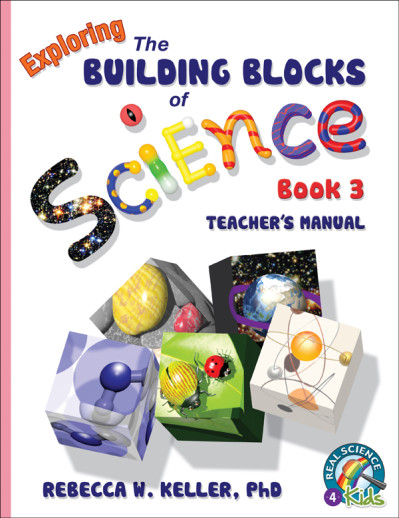We use cookies to make your experience better. To comply with the new e-Privacy directive, we need to ask for your consent to set the cookies. Learn more.
Exploring the Building Blocks of Science Book 3 Teacher's Manual
Building Blocks Product descriptions_1
Building Blocks Student Textbook - Introduce students to real science with the Exploring the Building Blocks of Science Student Textbook. Foundational scientific concepts and terminology are presented clearly and in a manner that's easy for kids to understand. Using this book gives kids a solid base on which to build a further study of science. This year-long curriculum contains four chapters of each of five scientific disciplines: chemistry, biology, physics, geology, and astronomy, as well as an introduction to the material covered and a concluding chapter for a total of 22 chapters. The many graphics in this full color textbook reinforce the concepts presented and make the book fun for kids and teachers alike to read.
Building Blocks of Science Laboratory Workbook - Introduce kids to the excitement of doing hands-on, real science experiments with the Exploring the Building Blocks of Science Laboratory Notebook. Each easy to perform experiment encourages students to use critical thinking skills and is organized around the scientific methodthe process real scientists follow in doing experiments. Inexpensive common household items and foods are used for the experiments, and the setup time is minimal. There are two experiments that coincide with each of the 22 chapters of the Exploring the Building Blocks of Science Student Textbook44 experiments in all.
Building Blocks of Science Teacher's Manual - Using the Exploring the Building Blocks of Science Teacher's Manual makes it easy for teachers to help students get the most out of the hands-on, real science experiments presented in the Exploring the Building Blocks of Science Laboratory Notebook. Instructions are provided for guiding students through the experimental process, and guided inquiry questions are suggested to help students think critically about the experiments they are performing. Inexpensive common household items and foods are used for most of the experiments, and a list of materials needed for each experiment is included.
Items listed in this section tend to be complete science programs with a teacher and student component, requiring few supplements besides science supplies.
This is the long-awaited complete curriculum from Gravitas Publishing. Dr. Keller has taken the topics used in her Focus on Science series and combined them into grade-level appropriate curriculum. At this time, grades 1 through 5 are available; keep watching for grades 6 through 8.
At the younger grades, this yearlong program includes three books a student text, lab workbook, and teacher manual. Student Texts vary in length and are divided into five topical areas Chemistry, Biology, Physics, Geology, and Astronomy; the topics are then divided into four chapters each, for a total of 22 chapters per book (introductory and concluding chapters round out the total). The book is printed in full color and incorporates the same adorable illustrations and characters found in the Focus on Science series, but these take each topic to greater depth. Each chapter is divided into numbered sections, and each could be used as one daily lesson. The number of sections vary by chapter from four to eight. Textual information is printed in a larger font for easy reading, there is plenty of white space so your visual learners won't be overwhelmed, and new vocabulary words are printed in red. The very last lesson of each chapter is a summary, so that students can review all of the information for that chapter. Softcover.
The Laboratory Notebook is a very important part of the program. This consumable book offers 44 experiments intended to complement the chapters found in the student text. Each experiment is divided into five steps to help students with the scientific process. Step one is 'Think About It,' and students are asked to write down what they think will happen in the experiment (hypothesis). Step two is 'Observe It,' in which students are asked to write down details about what they see happening. Step three is 'What Did you Discover,' where students are asked to answer some questions concerning their experiment. Step four is 'Why?' and offers a brief discussion on the topic of the experiment and what you might have observed. 'Just for Fun' is step five and has an extra activity or experiment for the student to do (these experiments are included in the total of 44 experiments). The black and white pages of the lab notebook are formatted for students to fill in the information as they work through the activity or experiment and permission is given for photocopying within a family.
The Teacher's Manual is a guide to the experiments found in the lab notebook. A complete materials list (items from your home or easily accessible) is given at the front of the book for convenience of preparing. Listed for each experiment is the materials list, objectives, and additional information for each step of the experiment given in the lab notebook. The experiments can usually be done in an hour or less.
If you are looking for a good science course that deals with the facts, Dr. Keller has proven that her materials are solid and age-appropriate. She now gives you a choice between her topical studies or doing a complete curriculum. ~ Donna
Topics in Book 3 include: mixtures, polymers, DNA, plants, the plant life cycle, hydrosphere, biosphere, earth's magnetic field, galaxies, celestial objects, electricity, magnets, and more.
| Product Format: | Paperback |
|---|---|
| Brand: | Gravitas Publications |
| Grade: | 3 |
| ISBN: | 9781941181034 |
| Length in Inches: | 11 |
| Width in Inches: | 8.5 |
| Height in Inches: | 0.5 |
| Weight in Pounds: | 0.7 |

